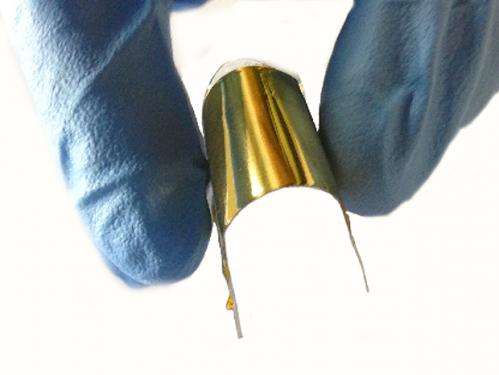January 29, 2015 weblog
Skin device uses motion to power electronics

Can a skin patch power wearables? Skin-based generators have become an area of focus among researchers working on how to scavenge muscle motion whereby skin becomes a charge-collector. A detailed report in IEEE Spectrum said on Wednesday that a team from the National University of Singapore has come up with a generator that converts muscle movements into enough power for small electronics. The device can generate 90 volts of open circuit voltage when touched gently with a finger. The device is as small as a postage stamp. Lokesh Dhakar said in the IEEE Spectrum report that his main goal was to make the device highly flexible so it could conform to human skin well in a patch of any size. Their device was presented at an IEEE conference in Portugal earlier this month which focused on Micro Electro Mechanical Systems, the MEMS 2015.
ExtremeTech talked about the underlying triboelectric effect, which makes the device work. This is when certain types of materials can be electrically charged through contact and friction with another material. "When the two materials are pulled apart, they generate a current that can be harvested. An electrode is needed in order to harvest the current, so the research team installed a 50nm-thick gold film to get the job done. The gold film sits below a silicone rubber layer composed of thousands of tiny pillars that help create more surface area for skin contact, which in turn creates more friction." Or, as Prachi Patel explained it in IEEE Spectrum, "electrical charge builds up on two dissimilar surfaces when they're put in close contact. When they are pulled apart or flexed, a potential difference is generated and a current starts flowing between them that can be collected using an electrode." How they tested: They attached the device to the subject's forearm or throat, using the motions of fist-clenching or speaking. The two motions produced 7.3V and 7.5V, respectively. "Tapping the device generated the highest voltage of 90V and power of 0.8mW, said Dhakar. This could light up 12 commercial LEDs."
The device can be used as a wearable self-powered sensor to track the user's motion and activity. "Such friction-powered generators could usher new types of wearable sensors that don't require batteries but instead are powered by the wearer's daily activities like walking, talking or holding an object," said IEEE Spectrum. James Plafke in ExtremeTech also reflected on the potential of translating this device into everyday use: "This type of generator could remove the need for batteries in certain mobile devices—your smartwatch or fitness tracker could be made even thinner and lighter. Who knows—one day this type of generator could even generate enough energy to power your smartphone, perhaps even removing the battery entirely, which is one of the biggest constraints to smartphone development and design."
© 2015 Tech Xplore



















